
10月の誕生石:オパールとトルマリンを探る
10月生まれの人には、トルマリンとオパールという2つの伝統的な誕生石があります。どちらも美しく多様な色彩と視覚効果を持つ、他に類を見ない宝石です。
9月と同様に、10月はラテン語の「8」を意味するoctoに由来し、10ヶ月から成る古代ローマ暦における本来の位置づけに由来しています。アングロサクソン人は10月の満月で冬が始まると信じていたため、10月を「冬の満月」を意味するWinterfyllethと呼んでいました。
興味深いローマの10月の祝日の一つに、生者と死者の領域が互いに開かれたムンドゥス・パテトがありました。
今日では、死者の日(ディア・デ・ロス・ムエルトス)やハロウィンといった同様の祝日が10月に祝われます。10月は、達成感、蒔いた種を刈り取る、そして人生の循環を象徴しています。
その象徴が10月の誕生石と合致するかどうか見てみましょう!今日は、トルマリンとオパールの歴史、特性、意味、そして10月の誕生石としての用途についてご紹介します。
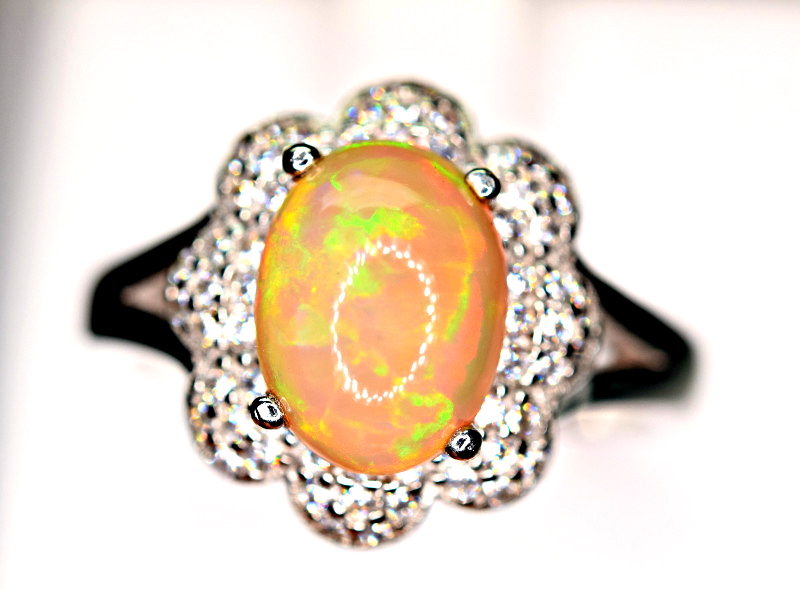 上の写真:貴重なオパールリング
上の写真:貴重なオパールリング
10月の誕生石の歴史的・文化的意義
10月の正式な誕生石は何ですか?10月の誕生石として公式に指定されている半貴石は、オパールとトルマリンの2つです。
でも、なぜ10月の誕生石は2つあるのでしょうか? 実は、昔から2つあったわけではありません。
最初の誕生石リストは、聖書の宝石リストにヒントを得て西暦 1 世紀から 5 世紀にかけて作成され、10 月の誕生石は緑柱石(具体的にはアクアマリン) とされていました。
現代の正式な誕生石リストは、1870年にティファニー社が「グレゴリオ暦の誕生石の詩」のパンフレットを出版したときに始まりました。10月の詩はオパールについてでした。
最初の標準化されたリストは、1912 年に全米宝石協会 (現在の米国宝石協会) によって作成され、オパールを 10 月の主な誕生石として指定し、トルマリンを代替として指定しました。
1950 年代に、アメリカ宝飾品産業協議会は 1912 年のリストを修正し、10 月の代替品としてピンク トルマリンを具体的に指定しました。
最新の2016年版アメリカ版リストでは、10月のオパールとピンクトルマリンの優先順位は同等です。2013年版イギリス版リストではオパールのみとなっています。
驚くべきことに、「暗くて不気味な」10月を称えるこの2つの名曲は、主に虹にまつわる言い伝えに根ざしています。
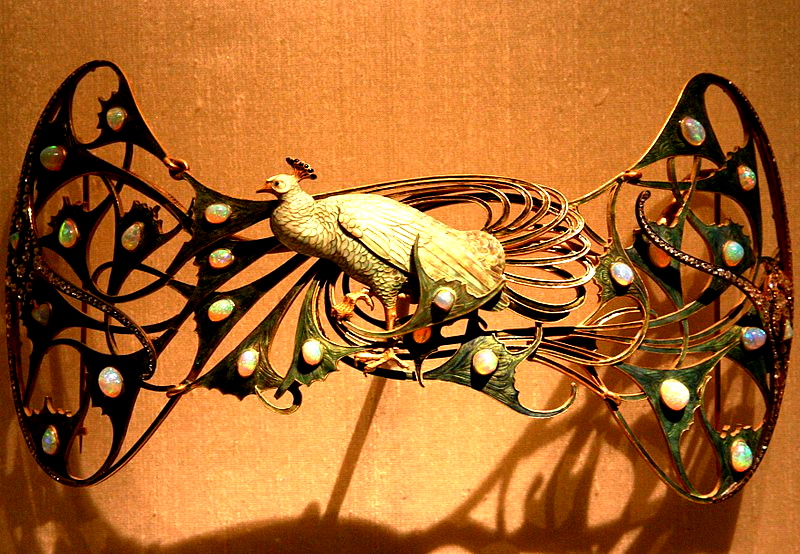 上の写真: ルネ・ラリック (1860-1945)。 「ピーコック」コサージュ装飾、1898~1900年頃、金、オパール、ダイヤモンド、エナメルを使用。カルースト・グルベンキアン美術館 |画像クレジット: © José Luiz Bernardes Ribeiro / CC BY-SA 3.0
上の写真: ルネ・ラリック (1860-1945)。 「ピーコック」コサージュ装飾、1898~1900年頃、金、オパール、ダイヤモンド、エナメルを使用。カルースト・グルベンキアン美術館 |画像クレジット: © José Luiz Bernardes Ribeiro / CC BY-SA 3.0
オパールの神話的起源と古代の民間伝承
古代ギリシャ人は、オパールは天空の神ゼウスがタイタン族を倒した後に流した歓喜の涙から形成されたと信じていました。
古代ローマ人はオパールを宝石の女王とみなしていました。ローマの学者、大プリニウスは、オパールはルビー、エメラルド、アメジストといった他の貴重な宝石の最高の性質をすべて備えていると記しています。
オーストラリア先住民(「アボリジニ」と呼ばれることもある)のオパールの伝承は数世紀前に遡ります。
オパールの起源に関する神話の一つに、虹の蛇という強力な存在が水たまりの間を飛び回り、その虹色の鱗がオパールとなって地上に落ちたというものがあります。
オーストラリアのオパールの起源に関するもう一つの神話では、祖先の創造主の霊が虹に乗って地球に降り立ち、その足が地面に触れた場所にオパールが出現したとされています。
古代インドの神話によれば、地母神は虹の処女神をオパールに変え、彼女を追う複数の神々の望まない愛情から逃れられるようにしたと言われています。
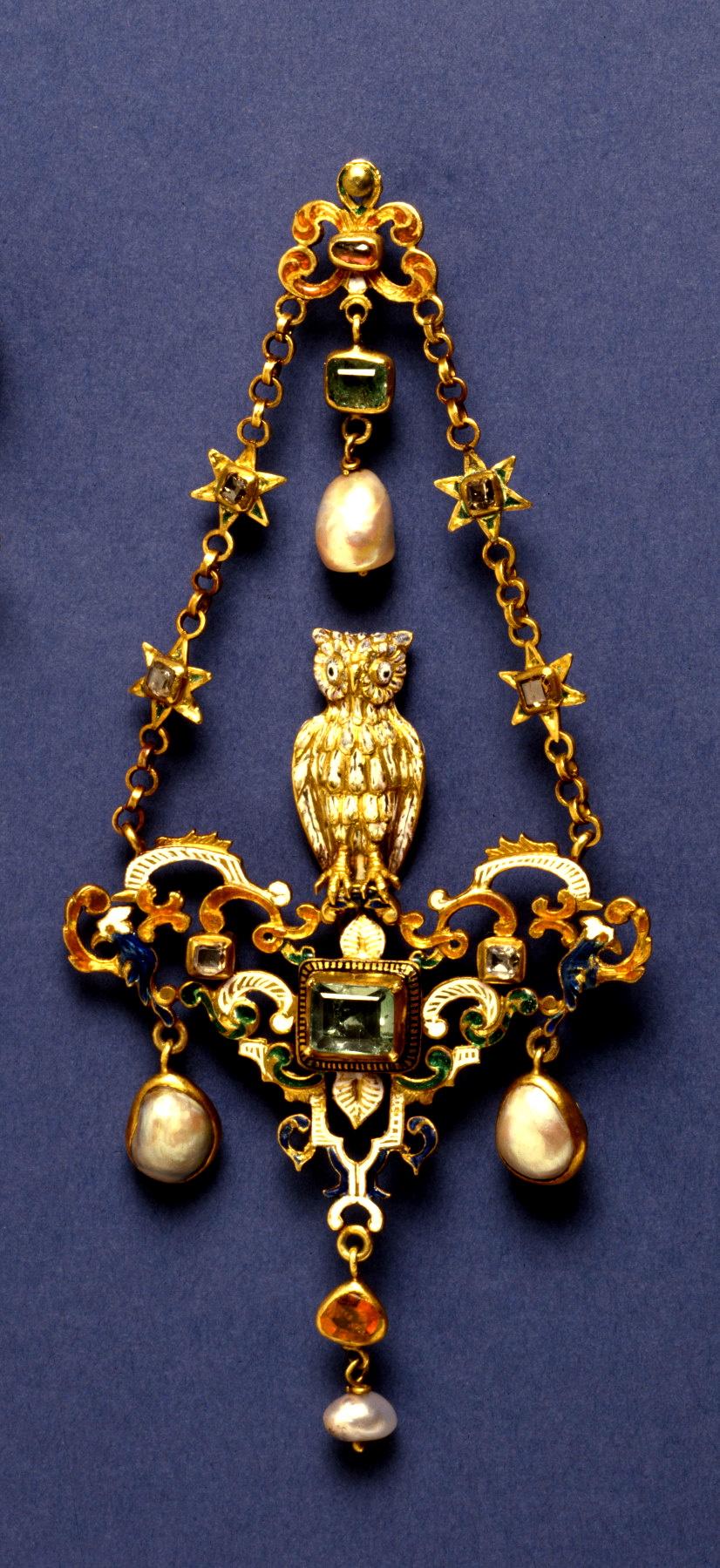 上の写真:トルマリン、ルビー、ダイヤモンド、真珠をあしらった金のフクロウのペンダント。19世紀の作品だが、以前は16世紀のものと考えられていた。ウォルターズ美術館に展示|画像提供:ウォルターズ美術館、パブリックドメイン
上の写真:トルマリン、ルビー、ダイヤモンド、真珠をあしらった金のフクロウのペンダント。19世紀の作品だが、以前は16世紀のものと考えられていた。ウォルターズ美術館に展示|画像提供:ウォルターズ美術館、パブリックドメイン
トルマリンの多様な歴史的つながり
トルマリンはオパールよりも歴史が少し短いですが、同様に魅力的です。
この10月の誕生石の名前は、シンガレーゼ語(スリランカ語)の「turmali」(混合宝石)に由来しています。オランダ商人がスリランカの宝石箱に入っていた色とりどりの石にこの名前をつけました。
オランダにおける「ショール」(黒トルマリン)の取引は、少なくとも 1400 年代にまで遡ります。
トルマリンのもう一つの歴史的な発見は1554年に起こりました。スペインの征服者フランシスコ・スピノザがブラジルで緑色のトルマリンを発見し、「ブラジルのエメラルド」と名付けました。
トルマリンの誤認でもう一つ注目すべきものは、「シーザーズ・ルビー」です。これは1500年代にフランスからロシアの王族の間で歴史を持つ赤い石です。1920年代にルベライトトルマリンであることが発見されました。
実際、1785 年に最初の種 (ショール) が分析されるまで、商人は有色トルマリンを他の宝石と呼んでいたようです。この種は、1808 年にホウ素が発見されるまで完全には認識されていませんでした。
1892年にカリフォルニアでトルマリンが発見された後、同州産のピンクトルマリンの多くは、この宝石を好んだ中国の皇太后、子熙に売られました。
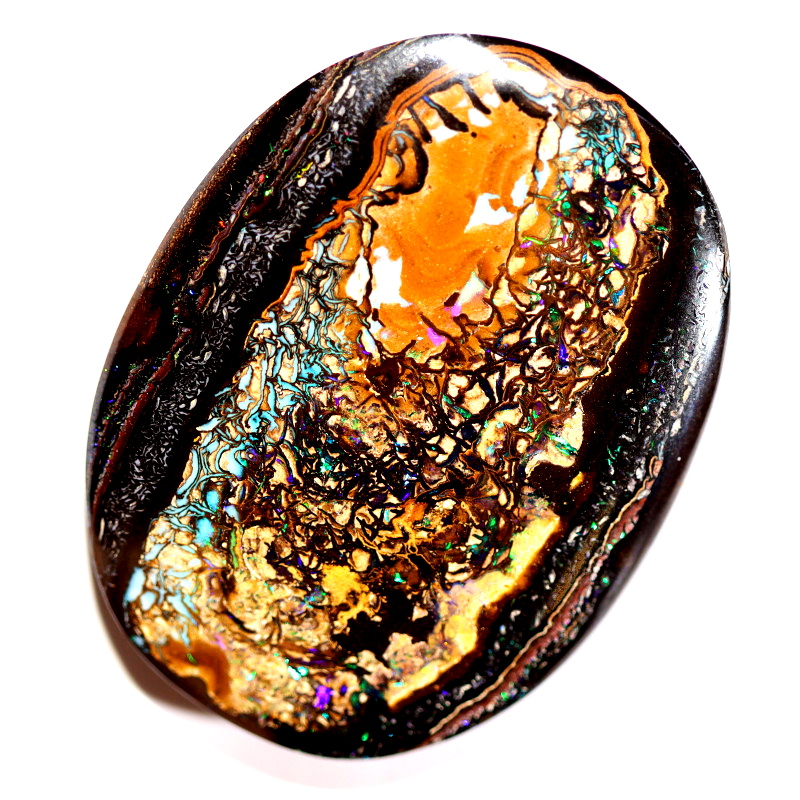 上の写真:研磨されたマトリックスオパール
上の写真:研磨されたマトリックスオパール
地質学的驚異:オパールとトルマリンの形成
オパールをはじめとするこれらの宝石は、結晶構造を持たない非晶質鉱物です。シリカと様々な水分含有量で構成されています。
オパールは、シリカを溶解した水が鉄鉱石の割れ目や流紋岩晶洞(「雷卵」)のような場所に沈殿することで形成されます。水が蒸発すると、ゲル状の物質が固まってオパールになります。
宝石は、古代の海の生物(例: オパール ベレムナイト)や木材などの化石の周囲に形成されることもあります。
しかし、オパールは宇宙の石でもあります!2015年と2023年の両方で火星でオパールが発見され、火星に水が存在することが証明されました。
10月の誕生石トルマリンも似たような形をしています。
非常に深い高温の熱水鉱床では、ホウ素とシリカを溶解した水がマグマの割れ目に沈降することでトルマリンが形成されます。マグマは徐々に固まって岩石となり、水は蒸発し、成分は結晶化します。
採掘場所
世界の貴重なオパールの約95パーセントはオーストラリアから産出されます。
トルマリン宝石のほとんどはブラジルやアフリカ諸国から産出されます。アメリカ合衆国カリフォルニア州はピンクトルマリンで有名です。
 上の写真:一般的なオレンジ色のファイアーオパール、ファセットカット
上の写真:一般的なオレンジ色のファイアーオパール、ファセットカット
 上の写真:鮮やかな遊色効果を見せるオーストラリア、ライトニングリッジ産の貴重なオパール
上の写真:鮮やかな遊色効果を見せるオーストラリア、ライトニングリッジ産の貴重なオパール
オパールの遊び心のある色彩:その中の魔法を解き放つ
最も広いオパールのカテゴリーは、一般的なオパールと貴重なオパールです。
10月の誕生石であるオパールは、水に囲まれたシリカ球で構成されています。球が不規則で大きさが不揃いな場合はコモンオパール、均一な大きさで整列した球(バッキーボールのような)の場合はプレシャスオパールとなります。
表面から虹色のような色がきらめく遊色現象が見られるのは「プレシャスオパール」だけです。
注: 宝石学者の中には、「遊色効果」を「乳白色」と同義語として用いる人もいます。また、乳白色または真珠のような外観を、一般的なオパールに見られる現象と定義する人もいます。
さまざまな種類のオパールは、主にボディトーン(背景色)、透明度、遊色効果によって分類されます。
オパールのボディトーンの主な種類は、ホワイトオパール、グレーオパール、ブラックオパールです。これらはボディトーンチャートを用いて区別されます。
他のボディカラーのオパールには以下のものがあります:
無色のオパールには、クリスタルオパール、コントラルズオパール、ジェリーオパールなどがあります。ハイアライトオパールは無色の場合もあります。ハイドロファンオパールは水中で透明になり、無色になります。
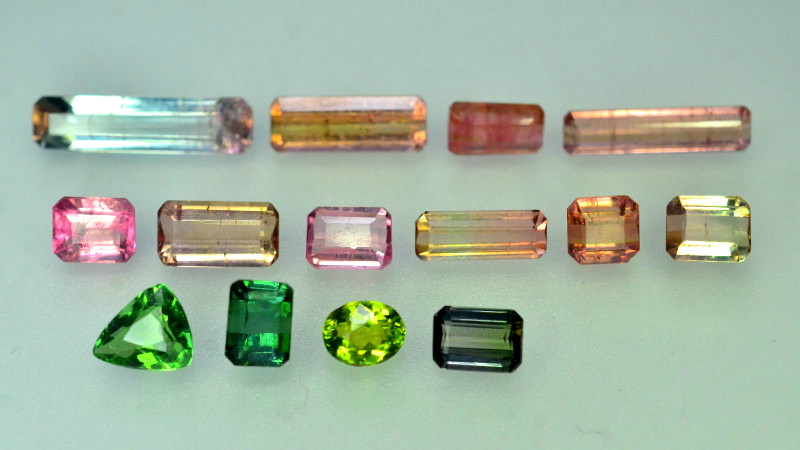 上の写真:さまざまな色と種類のファセットトルマリン
上の写真:さまざまな色と種類のファセットトルマリン
トルマリンの多様な表情
「トルマリン」は実際には30種類以上の鉱物からなる複雑で多様なグループです。最も一般的な種は以下のとおりです。
ショール:最も一般的な種。天然トルマリンの約95%を占める。茶色から黒色。
ドラバイト:比較的一般的。「ブラウントルマリン」という愛称で呼ばれるが、他の色の場合もある。
エルバイト:最も一般的な宝石質の種であり、最もよく知られ、最も価値がある。実質的にあらゆる色、あるいは多色のものがある。
それぞれの種によって異なる色のトルマリンが産出されます。最も一般的に販売されているトルマリンの種類は以下の通りです。
ブラックトルマリン:ショール種のみ。最も一般的なトルマリン。常に不透明。
クロムトルマリン:ドラバイト;希少な鮮やかな緑色
インディコライト:エルバイト;主に青色
パライバトルマリン:エルバイト;鮮やかなネオンブルーから青緑または紫
ルベライト:通常はエルバイト。濃いピンクからルビーレッドの変種で、紫、茶色、オレンジの色合いのものもある。
ヴェルデライト:エルバイト。緑色の変種で、「ブラジル産エメラルド」や「セイロン産ペリドット」と呼ばれることが多い。
ウォーターメロントルマリン:エルバイト;ピンクと緑の2色で、中心はピンク、縁は緑で、無色の層で区切られていることもある。
シベライト:エルバイト、ルベライトの亜種と考えられることもある。「紫トルマリン」とも呼ばれるが、通常は赤紫色または赤紫色である。
誕生石のピンクトルマリンはエルバイト変種で、ルベライトやシベライトに分類されることが多いです。ピンクとグリーンのウォーターメロントルマリンや、ピンクとオレンジの「サンセットトルマリン」など、マルチカラーの選択肢もあります。
トルマリンの中で最も希少な種類はパライバトルマリンです。純粋な黄色、オレンジ色、青色、紫色、あるいは色が変化するトルマリンも希少です。
トルマリンが珍重されるもう一つの要素は多色性です。強い多色性を示す標本はより価値が高くなります。
価値といえば、10月の誕生石はどのように評価されるのでしょうか?
 上の写真:ファセットカットのウォーターメロントルマリン
上の写真:ファセットカットのウォーターメロントルマリン
品質評価:オパールとトルマリンの特性
トルマリンのグレーディングはオパールよりもはるかに簡単です。以下では、オパールとトルマリンの両方について、宝石の価値を左右する標準的な要素(色、カット、クラリティ、カラット重量、処理)に焦点を当てます。オパールの価値のグレーディング方法について詳しくは、こちらをご覧ください。
色
オパール:これらの誕生石の価値を決める主な要素は、オパールの色(ボディトーン)と遊色効果の有無です。ボディトーン別に見ると、オパールの色は白が最も多く、次いでグレーとグリーンが続きます。最も希少なのは黒と赤です。全体的に見て、プレシャスオパールはコモンオパールよりもはるかに価値があります。
最高の遊色効果は、赤色(またはすべての色)の閃光と独特の模様を呈し、石の表面全体を覆います。貴重なブラックオパールのような濃い色の標本は、より鮮やかな遊色効果を示し、その価値を高めます。
トルマリン:10月の誕生石の中で、最も希少で価値の高いトルマリンはパライバトルマリンです。黒、赤、ピンクのトルマリンが一般的です。鮮やかな緑や青の多色性、つまり色の変化が、誕生石の価値を高めることがあります。
カット
オパール:オパールは他の宝石ほどファセットカットされることは多くありません。 ファセットカットされるのはファイアーオパールだけです。オパールはカボションカットやビーズカットされているのをよく見かけます。遊色効果は、半透明から不透明のオパールカボション、または完全に透明なファセットカットオパールで最もよく見られます。多くのオパールカボションは、オパールダブレットやオパールトリプレットのような複合石です。
トルマリン:トルマリンはファセットカットされることが多く、長方形の形状が多いです。パライバトルマリンのような価値の高い種類には、ブリリアントカットが選ばれることもあります。内包物の多いトルマリンはカボションカットや彫刻作品に加工されることが多く、バイカラーのトルマリンはスライスカットされることもあります。
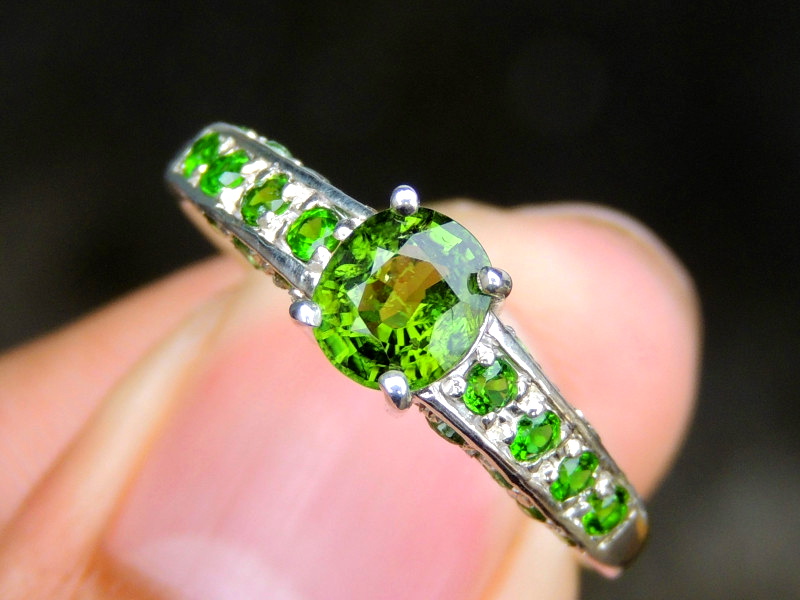 上の写真:ファセット加工されたクロムトルマリンリング
上の写真:ファセット加工されたクロムトルマリンリング
明確さと透明性
クラリティは、石に含まれる目に見える内包物の度合いを表し、石の透明性と価値を低下させます。
オパール:内包物は一般的にオパールの価値を下げます。オパールの周囲に内包物や付加物が存在する場合、デンドリティックオパール、マトリックスオパール、ボルダーオパールといった異なる種類のオパールが生まれます。
オパールにおいて完全な透明度を持つものは稀少で貴重ですが、ブラックオパールはより不透明度が高いです。濁りがあると、通常、価値は下がります。
トルマリン:ほとんどのトルマリンはタイプIIのクラリティを持ち、目に見える程度の小さな内包物が見られることが想定されます。クロムトルマリンとグリーントルマリンはタイプI(通常は内包物なし)ですが、パライバトルマリン、ルベライト、ウォーターメロントルマリンはタイプIII(常に目に見える内包物あり)です。
目に見える内包物が多く、透明度が低いトルマリンは価値が低くなります。唯一価値を高めるのは、シャトヤンシー(キャッツアイ効果)をもたらす、一列に並んだチューブ状の内包物の存在です。
トルマリン自体はトルマリン入りクォーツに含まれる内包物です。
カラット重量
オパール: ブラックオパールやクリスタルオパールなどの希少なオパールは、1〜5カラット、5〜10カラット、10カラット以上などの間隔でカラットあたりの価格が急上昇する場合があります。
トルマリン:トルマリンの誕生石はサイズが様々ですが、5カラットを超えると価格が高くなります。種類も重要です。クロムトルマリンは5カラットまでが一般的ですが、パライバトルマリンは1カラットを超えるものはほとんどありません。
治療
オパール:未処理のオパールは、特にブラックオパールのような希少な種類は、処理済みのものよりも価値がはるかに高くなります。 オパールの処理の有無を検査する方法については、こちらをご確認いただくか、10月の誕生石を鑑定機関に持ち込んで確認することもできます。
トルマリン:トルマリンは処理によって価値が下がりますが、10月の誕生石であるこの石ではよく見られます。一般的な処理には、放射線照射、熱処理、亀裂充填などがあり、色や透明度を向上させるために行われます。
 上の写真:オーストラリア産ブラックオパールペンダント
上の写真:オーストラリア産ブラックオパールペンダント
10月の誕生石の意味と文化的信仰
10月の誕生石には、どんなスピリチュアルな意味があるのでしょうか?虹と関連しているというだけでなく、それぞれに独自の象徴性と神秘的な力があります。
オパールの意味
古代の解釈によると、オパールは純粋さ、希望、そして未来への展望を象徴しています。ローマ人はオパールをキューピッド・パエデロス、つまり「愛のように美しい子供」と呼んでいました。
1800年代にはオパールが呪いの迷信で一時的に汚されたこともありましたが、中国をはじめとする多くの古代社会では、オパールは幸運をもたらすと信じられていました。今もなお根強く残る迷信の一つは、10月生まれ以外の人がオパールを身に着けると不吉だというものです。
ヒーリングストーンとして、オパールの持つ力の多くは視力と精神に関係していると言われています。10月の誕生石であるオパールのヒーリングパワーには、視力障害の治療、認知能力の向上、未来を見通す力などがあると信じられています。
トルマリンの意味
10月の誕生石であるトルマリンは、全体として、思いやり、寛容さ、そして許しを象徴しています。「和解の石」と呼ばれることもあります。
トルマリンの色にはそれぞれ意味があり、癒しの力も持っています。特にピンクトルマリンは、10月にエネルギーを高め、愛を育み、人間関係のトラブルを解消する効果があると言われています。
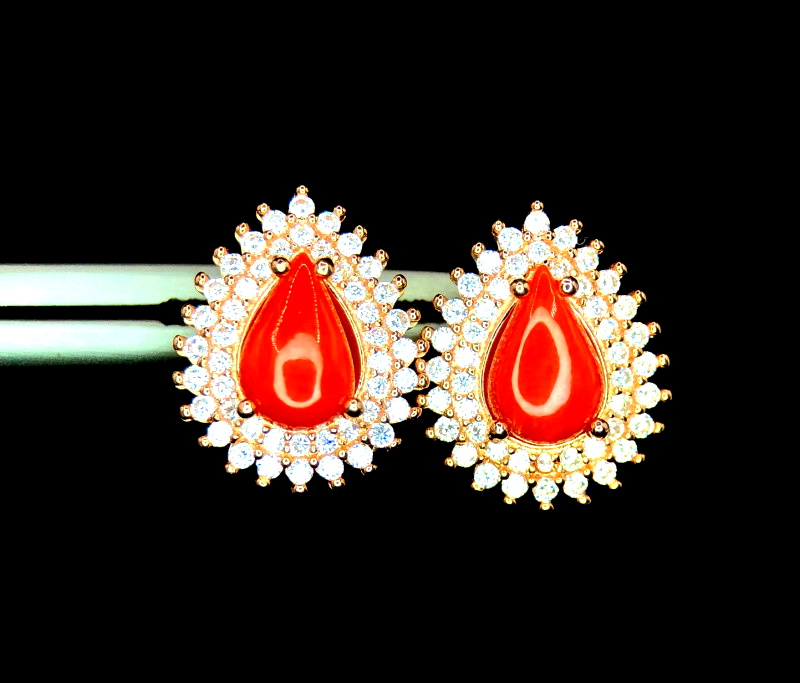 上の写真:赤珊瑚のイヤリング
上の写真:赤珊瑚のイヤリング
10月の代替誕生石
10月の誕生石で一番人気なのは?オパールは一般的に「定番」で、トルマリンよりも人気ですが、他にも10月の誕生石やクリスタルはたくさんあります!
10月の誕生石の代わりとして人気のあるのは、緑柱石と珊瑚です。
占星術的に、天秤座の誕生石は何ですか?9月生まれの天秤座(23日以降)の方には、ペリドット、ローズクォーツ、モルガナイトがおすすめです。
蠍座の誕生石はどうでしょうか?9月生まれ(23日まで)の蠍座の方は、ブラックトルマリン、マラカイト、サンゴがおすすめです。
10月の誕生石ギフト
宝石を手に入れたら、次は何をしますか? 10月生まれの大切な人への、心からのお祝いに、10月の誕生石を贈りましょう。
10月は最も一般的な結婚式の月の一つなので、10月の誕生石の指輪で祝うのも素晴らしい方法です。
10 月の誕生花であるカレンデュラをデザインした誕生石のネックレスなど、カスタマイズされたジュエリーを入手することもできます。
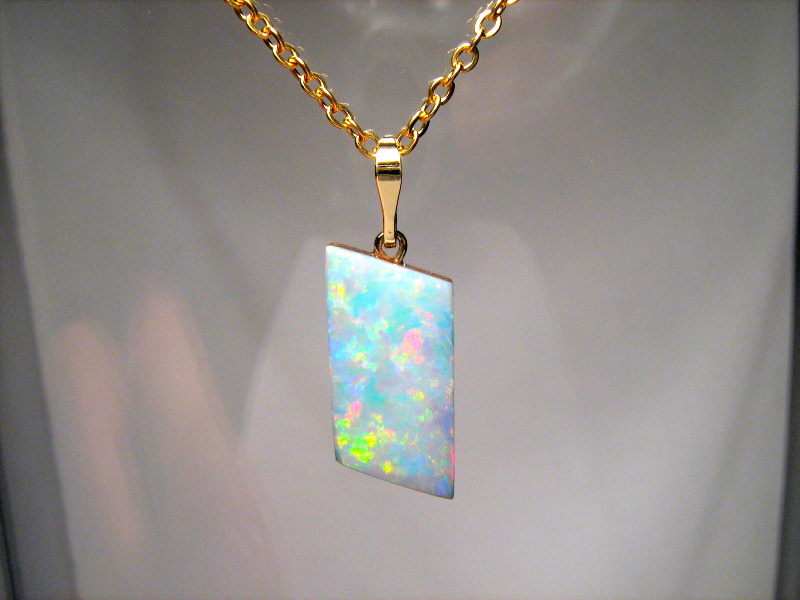 上の写真:ホワイトプレシャスオパールペンダントネックレス
上の写真:ホワイトプレシャスオパールペンダントネックレス
10月の誕生石に大喜び?
トルマリンとオパールはどちらも、その多彩な色彩とユニークな外観で愛されています。最近正式に認められたピンクトルマリン、昔ながらの伝統的なオパール、それとも他の10月の誕生石?どれがお好みですか?あなたの心の声に従って、あなたにぴったりの宝石を見つけてください!
弊社の数百種類の宝石から、伝統的な 10 月の誕生石や代替誕生石を探したり、 Opal Auctions で豊富なオパールのセレクションを閲覧したりしてください。
Gemstone Encyclopedia検索
関連オークション
最新記事
Thulite is a rare Norwegian gemstone exhibiting a vibrant rosy hue from the zoisite mineral family that is commonly used in jewelry settings and pendants.
6th Jan 2026
ビスムトタンタライトは、タンタライト鉱物群に属する希少な鉱物宝石です。比較的柔らかいため、ジュエリーセッティングには適していません。しかし、コレクターにとっては貴重なアイテムです。
5th Jan 2026
鮮やかな赤い模様と文化的意義で珍重される希少な宝石、チキンブラッドストーンの歴史、特性、価値、お手入れのヒントをご紹介します。
8th Dec 2025
記事のカテゴリ
How To's is where you will find helpful articles from gem Rock Auctions on how to cut gemstones, select gemstones and buy gemstones.
9記事数




